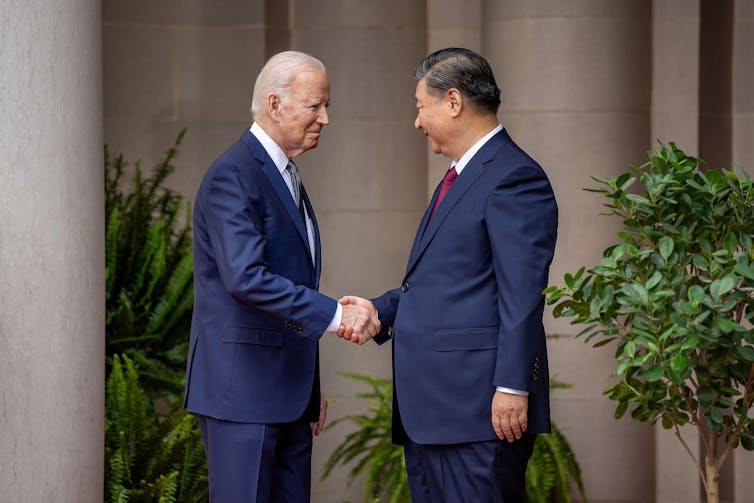Key Takeaway:
San Diego Zoo and China’s Wildlife Conservation Association signed a deal in February 2024 to return Chinese giant pandas to the US by the end of the summer. This move signifies a warming of relations between the US and China, as well as a bid by China to help repair its struggling economy. Panda diplomacy, where Beijing gives or loans its pandas as a sign of friendship or to strengthen national ties, has become part of China’s international image. By sending the pandas to California, home to the US technology industry, Beijing aims to woo the American public and boost its economy. The pandas represent China’s seal of approval towards a foreign nation and signal a plan to build a long, prosperous working relationship with Washington.
A deal was signed between San Diego Zoo and China’s Wildlife Conservation Association in February 2024 that paved the way for Chinese giant pandas to return to the US by the end of the summer.
But this is far more than just a deal between two zoos. It suggests a warming of relations between the US and China, and a bid by China to help repair its struggling economy.
For decades, China has used panda diplomacy, where Beijing gave or loaned its pandas as a sign of friendship or to strengthen national ties, to establish a good long-term relationship with other countries. However, in 2023, when China withdrew its giant pandas from the Smithsonian zoo in Washington DC, this seemed to symbolise how rocky the China-US relationship had become.
Two pandas were given as a gift to the US after President Richard Nixon visited China in 1972, and this was seen as a major breakthrough in modern US-China relations. From the 1990s onwards panda diplomacy was transformed into a long-term programme involving conservation and scientific study.
Panda diplomacy is part of what is called “soft power”, how nations use their culture or heritage to influence another country’s foreign policy. Pandas are soft and cuddly, and have what it takes to win hearts and minds. So, the pandas became part of an attractive part of China’s international image.
By sending these pandas to the US, Beijing intends to woo the American public, but also more specifically, California, the home of the US technology industry.
One reason for this is that Beijing needs to jump start its ailing economy. Foreign investment in China was lacklustre in 2022. But between July and September 2023 things got a lot worse, as foreign direct investment leaving the country outweighed that coming in. This had not happened since 1998.
A main reason for this drop in foreign investment stems from US restrictions on exports of semiconductor technology to China. This is related to US concerns that the chips could be used by China for military objectives. To turn the economic tide, China needs to repair its trade relationship with the US, and possibly get the US government to change its policy.

The two giant pandas are headed for California, home to both the Silicon Valley and San Francisco, currently the world’s centres for artificial intelligence development.
The potential of this technology is important for China. As well as the potential to add $600 billion (£474 billion) to the Chinese economy by 2030, it could provide an edge for China’s powerful military.
To become a world leader of artificial intelligence by 2030, China needs talent and technological know-how. But China’s ability to enhance its artificial intelligence capacity through domestic talent is constrained by an education system steeped in rote learning.
Beijing’s redeployment of pandas dials up the diplomatic goodwill several notches, signalling Beijing’s seriousness in improving links with Washington. After all, the pandas represent China’s seal of approval towards a foreign nation, and this move typically signals a plan to build a long, prosperous working relationship.
What’s the history?
The Smithsonian’s zoo, arguably the birthplace of panda diplomacy in the west, had been home to giant pandas since 1972. It was from November 8, 2023, that the zoo lost its giant pandas for the first time in more than 50 years, when Mei Xiang, Tian Tian and their offspring, Xiao Qi Ji were flown back to China.
At that point, there were suggestions that panda diplomacy was over as tensions between the US and China had risen significantly. Relations between US and Chinese businesses also seemed to be getting worse. A survey by the US-China Business Council of its members in 2023 found that 34% had stopped or reduced planned investment in China over the previous 12 months.
But later in November, China’s president Xi Jinping held a four-hour summit with President Joe Biden at the Asia-Pacific Economic Cooperation (Apec) conference in San Francisco and signalled that there was potential for rapprochement. Xi said that, in a world of challenges, the US and China “must handle our relations well”. Xi alluded to the pandas’ popularity with Americans.
He added that China is “ready to continue our cooperation with the United States on panda conservation”, and added that China will “do our best to meet the wishes of the Californians so as to deepen the friendly ties between our two peoples”.
Xi also set up a dinner with hundreds of tech executives including Apple CEO Tim Cook and business leaders on the sidelines of the Apec meeting. So it would seem logical that Beijing has decided to send its national treasures to California to signal the state’s importance to the Asian superpower.
It looks like Beijing’s willingness to send its bears back to the US is part of a strategy to improve not only its political relationship with Biden, but, perhaps more importantly, to help bring back US investment, and reframe Beijing as a friendlier trading power.





























